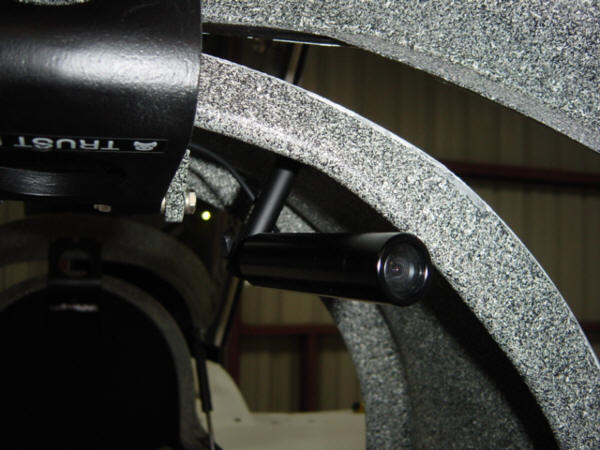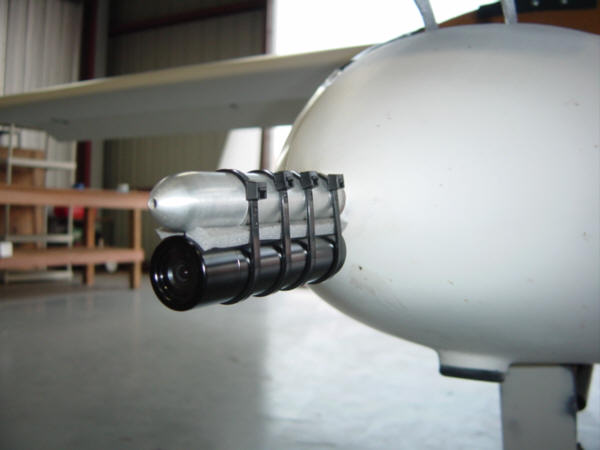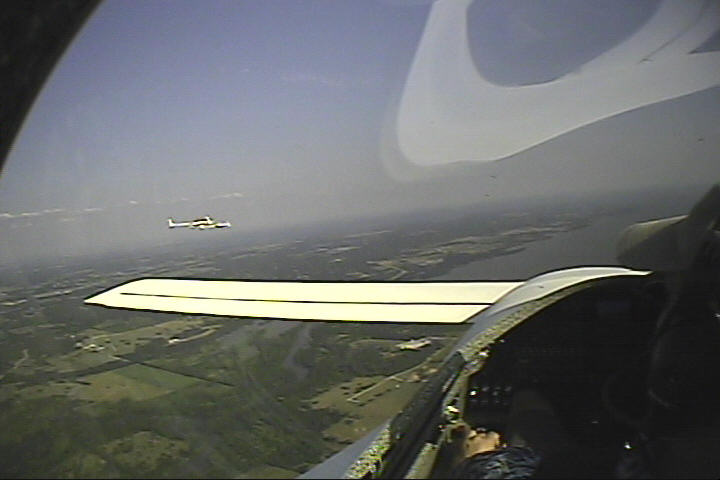

Several folks have asked about the camera setups, so I thought I would show some of the details. First, the "Bird with an Attitude" video footage was taken, in most part, from the various Berkut promotional videos. I shot a little "handheld" footage from the back seat of the Berkut prototype during a few demo flights some 10+ years ago and spliced it in. The "promo" video footage was shot professionally using multiple bullet cams mounted on different parts of the airframe and recorded on Beta decks. I really don't have any technical data on those components, and it really doesn't matter as it was all 10+ year old technology - much better/cheaper/digital stuff available these days. The aerobatic routines were flown by Rick Fessenden - the Berkut air show pilot.
Version 1 mount: My, self-made, videos will be incorporating several technologies that are generally available today. I also have some really kewl ideas for a remote camera pod, but those are still on the drawing board for the future. I started out with a Sony 4mm digital Handycam (model HC42), as the recording unit. It's light, compact, records digitally (no loss), and has a nice monitor/touch screen viewer. For now, I simply anchored it to the shoulder support bulkhead with a wing bolt. The batteries you see next to it are the temporary power supply for the little bullet cam. I'm using a very high-resolution bullet cam, that basically provides the same level of detail as the cam-corder itself. You can read more about it's technical specifications by Clicking HERE. Version 1.0 of the camera mount is just a simple 2" stalk mount that came with the camera. I've set it up so that I can installed it on either the left or right side of the roll-over structure. At this point, I have discovered a minor flaw - because the cam sticks out in from of the mount, it allows the cam to vibrate when the plane is at full power (harmonic vibrations) and distorts the video image. It's fine at lower cruise power settings, but I need to figure out a way to further stabilize it. For now, I just rigged up a strip of .040 aluminum and attached it to the drip rail with double sided tape. I think all I need to do is break the harmonic coupling and it'll be fine. If it works, I'll rig up something a little less "prototypical". This worked for a while, but the double stick tape comes off and the cam starts bouncing around...so, this setup will not work.
Version 2 mount: Now that I am addicted to making videos, I decided to try a more rugged mount. I ordered some RAM mount parts, and cobbled together a couple of mounts. The main bullet cam mount attaches to the shoulder harness bulkhead and stands up rather tall. This height is needed to "see" over the nose for those forward facing shots. The long arm also allows the cam to be pointed down the left wing. I can point it aft, and right, but the field of view is rather limited. I might shoot some video of a passenger someday...who knows. The same mounting hardware (with a shorter stalk) can be used to mount the camcorder on the aft bulkhead. It's only useful when there is no passenger and can only take air-to-air shots. I have not used this config yet, but the test show it is at least stable.
I have also used the bullet cam for diagnostic purposes. I was having some gear vibration issues, so I quickly mounted the cam to the gear leg so I could see what the brakes were doing during high-speed taxi. It was a quick and dirty install, but it worked perfectly...and stayed on at almost 100mph too.
I'll post more here as I experiment with alternate mounting positions, and progress with the camera pod design.

OK, with the camera pod on the back burner, and the version 1 being too jittery...I tried thinking out-of-the-box - actually, out-of-the-airplane! I got out the old tie-wraps and went to work. What I had when I was done, was pure genius - a free-flight point of view camera mount. I put the battery pack in the nose utility compartment, wrapped the recorder in a towel and put it in the front baggage area, and used some white tape to secure the wire.. Best yet - it really WORKS! Perfectly stable and the shots make it look like you are Superman. This is going to be a favorite mount point for filming "chase" footage, terrain and cloud dancing. You'll see a lot of this in the upcoming videos - here is a quick screen shot (200kt. low approach).

Why so loose in formation? Some of my viewers have been asking me about the "loose formation" flights in my videos - they are loose on purpose. OK...here's the deal for those that don't know - from a "video production standpoint" true formation work generally makes for boring video with a fixed camera! Can we fly closer?...Yes, but choose not to. I only have the cameras mounted in a fixed position at the moment (and no way to see what's in frame), so I usually fly on the outside position looking up the formation. Then, when all the aircraft are lined up in a row, and we are in correct alignment, all you get to see is a blob of aircraft. Now, if I take that same shot, with the planes slightly out of formation, the results are much more pleasing. Hence why you will not likely see much "tight" formation work in the videos unless it's one-on-one work and I can figure out a way to know what's in frame - and even then it depends on how comfortable and practiced I am with the other pilots.
Why do the other aircraft look so small? Another challenge with making good video is the physics of light. You see, the reality is that even when I am in close with other airplanes, it still looks further away than it is. The aircraft in the video appear much smaller in aspect than they actually are in real life. The reason for this effect is the wide angle lens used on the bullet camera - it acts like much a parabolic mirror does. You are probably familiar with the message on your passenger side rear-view mirror: "Objects in the mirror are closer than they appear". As good as cameras are, there is still no substitute for the human eye. Second, these videos to date are photo missions, not formation routines and especially not formation aerobatics! (I'm certainly not at that skill level yet) If you want to see some of that kind of footage, check out GlassOvercast.com for some really spectacular formation routines. Thirdly, and not un-importantly, since the pilot skill levels usually vary greatly, you will usually see broad aircraft spacing in the videos. (yes, we pre-brief and agree on the approximate "comfort distance" for all ships) It's not the greatest for video production, but unless you fly formation with the same folks all the time, and practice and practice...and practice some more, it's just not safe. Flying in a tight formation is...well...unforgiving of any mistakes. Space & distance = time = safety margin.
What music are you using? Music is as follows...Berkut Attitude: Joe Satriani - "Speed of Light"; Canard Cruisin: Joe Satriani - "Friends"; Canard Fun: Era - "The Mass" (melody from Carl Orf's Carmina Burana); 5 canards + 1 Waco: Era - "Voxifera"; Power of the Dream: Celine Dion - "The Power of the Dream" (1996 Winter Olympics); Berkut Fun 2005: Era - "Enae Volare (Mezzo)"; One Big Rush: Joe Satriani - "One Big Rush".
 Back to the Proto-page
Back to the Proto-page